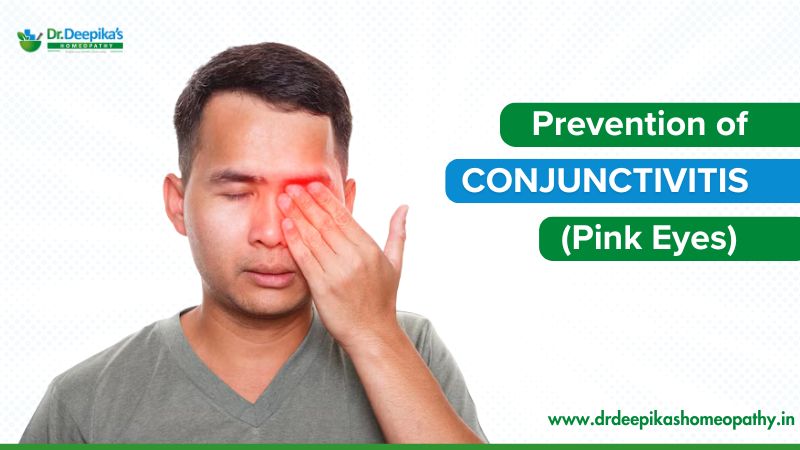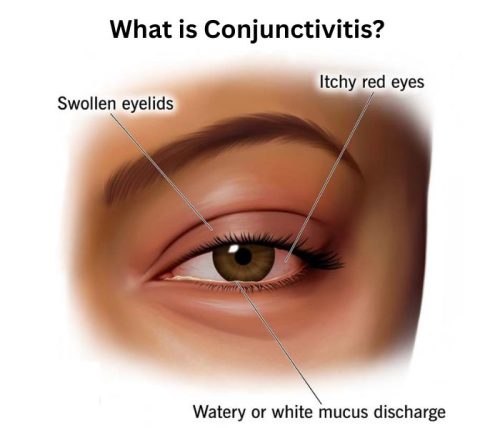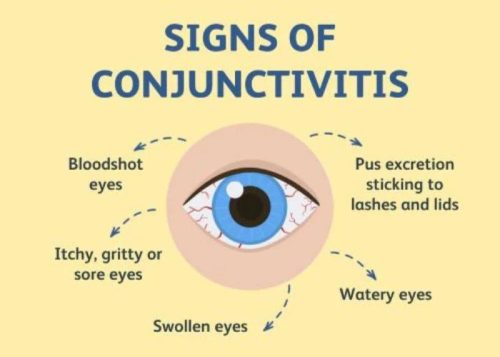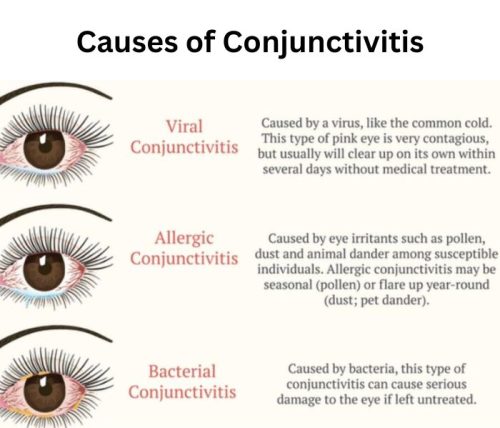
Prevention of Conjunctivitis (Pink Eye)
Conjunctivitis is an infection or inflammation of the conjunctiva, the transparent membrane that covers the white eye and inner eyelid. This irritation often causes redness or a pinkish hue, giving it the name ‘pink eye.’
It may occur in one eye or both and tends to be contagious, particularly in schools, offices, and populated areas.

Symptoms of Conjunctivitis
Conjunctivitis, also known as pink eye, is an ailment where the thin membrane in the eye and eyelids becomes inflamed. Depending on what’s causing it—viral, bacterial, or allergic—symptoms can be different, but certain symptoms occur in all varieties.
- Red or Pink Eyes
One of the earliest and most noticeable symptoms is redness or a pinkish hue, caused by the swelling of blood vessels in the conjunctiva.
- Watery or Sticky Discharge
Viral conjunctivitis tends to result in a clear, watery discharge and redness and irritation of the eyes.
Bacterial conjunctivitis usually causes a thick, yellow, green, or white discharge.
The discharge tends to glue your eyelids together, particularly after sleep.
- Itching or Burning Sensation
A continuous sensation of burning, itchiness, or irritation in the eyes is usual, especially in allergic conjunctivitis.
- Puffy Eyelids
Eyelids can appear puffy and heavy, especially upon waking.
- Gritty or Sand Sensation
It is as if there is dust or sand in the eye, but in reality, nothing is there.
- Excessive Tearing
The eyes can become watery excessively, especially with viral or allergic conjunctivitis.
- Crusting on Lashes
Discharge can become dry on the lashes and crust over, causing it to be hard to open the eyes upon waking.
- Sensitivity to Light (Photophobia)
Eyes can become light-sensitive in some instances, particularly in viral or allergic conjunctivitis.
- Blurred Vision
Slightly blurry vision may result from watery eyes or sticky discharge, but it often clears after rubbing the eyes.
- One or Both Eyes Involved
Conjunctivitis usually begins in one eye and can progress to the other, particularly in viral and bacterial forms.

Causes of Conjunctivitis
Conjunctivitis can be caused by various reasons. Knowing the reason helps in deciding the appropriate treatment and avoiding further transmission.
- Viral Infections
Viral conjunctivitis is usually linked to cold-causing viruses and spreads easily through sneezing, coughing, or touching infected objects or surfaces.
- Bacterial Infections
Bacterial conjunctivitis is caused by bacteria such as Staphylococcus or Streptococcus, resulting in a yellow or green discharge that is sticky and red.
- Allergies
Allergic conjunctivitis happens when the eyes respond to allergens such as pollen, an antigen, or pet dander. It’s non-contagious and often occurs seasonally.
- Chemical Irritation
Contact with smoke, dust, or chemical fumes may irritate the eyes and cause conjunctivitis.
- Foreign Particles
Dirt, makeup, or contact lenses that are irritating to the eyes can cause redness and infection.

Prevention of Conjunctivitis
Prevention of conjunctivitis is possible with simple daily habits. Here are some useful tips to help prevent conjunctivitis:
- Good Hand Hygiene
Wash your hands often with soap and clean water. This prevents germs from spreading that can cause conjunctivitis. Clean your hands always before and after touching your eyes, putting in eye drops, or touching contact lenses.
- Refrain from Touching Your Eyes
Even when your hands are germ-free, be careful not to rub or touch your eyes. This will deliver the bacteria or virus onto the eye surface and risk infection.
- Use Personal Towels and Pillow Covers
Never share towels, napkins, eye makeup, or pillowcases with anyone else. These can harbor infectious agents. Clean them frequently with hot water to destroy any remaining germs.
- Clean Contact Lenses Carefully
If you use contact lenses, have a strict cleaning and storage regimen. Use a new cleaning solution each time and never reuse old solutions. Never wear lenses overnight, and change them as directed by your eye care professional.
- Do Not Use Expired Eye Products
Do not use old or previously opened eye drops, mascara, or eye makeup. They can become a breeding ground for bacteria and cause irritation or infection.
- Safeguard Eyes Against Allergens
If you are susceptible to allergic conjunctivitis, shield your eyes from frequent causative agents such as pollen, dust, and pet dander. Close windows during peak pollen months and wear sunglasses when you are outside to minimize exposure and irritation.
- Stay Home When Infected
If you or your child develops symptoms of conjunctivitis, including redness, discharge, or irritation, stay home from work, school, or social gatherings. This prevents passing the infection on to others and enables appropriate rest and recovery.
Homeopathy Medicine for Conjunctivitis
Homeopathy medicine for conjunctivitis provides soothing relief by addressing symptoms like redness, itchiness, and discharge, offering remedies for bacterial, viral, or allergic forms.
- Euphrasia Officinalis – In watery, stinging discharge and burning eyes; aggravated by close air.
- Belladonna – For acute redness, dryness, and photophobia.
- Pulsatilla – For thick yellow-green discharge and itchiness; well-suited for gentle, easy-going personalities.
- Apis Mellifica – For watery, inflamed eyelids with burning, stinging pain.
- Argentum Nitricum – For adhesive eyelids, burning, and sensitivity to heat.
- Sulphur – For long-standing cases of burning, itching, and redness, worse on heat.
Disclaimer
Homeopathy medicines for conjunctivitis should be taken under the supervision of an experienced homeopathy physician. Self-treatment might not be appropriate in all cases. This is for informational purposes only and is not a substitute for professional medical advice, diagnosis, or treatment.
How to Reduce Eye Infection Naturally?
While medical treatment is crucial, natural remedies can aid healing and prevent infection. Below are easy methods to help decrease eye infections naturally:
- Practice Good Hygiene
Do not share towels and avoid bringing your hands to your face. Use a clean pillowcase and towel, and avoid sharing personal items such as eye drops or cosmetics.
- Use a Warm or Cold Compress
Apply warm compresses to comfort bacterial eye infections, with cold compresses relieving itching and swelling in allergic conjunctivitis.
- Wash your Eyes with Clean Water
Wash your eyes gently with clean, lukewarm water to wash out irritants. Avoid unfiltered or untreated water.
- Do Not Wear Contact Lenses
If you wear contact lenses, switch to glasses until the infection clears, as lenses can worsen the irritation.
- Rest Your Eyes
Reduce screen time, do not read in low light, and use sunglasses to shield your eyes from dust and sunlight.
Consult with Dr. Deepika
Dr. Deepika, the Best Homeopathy Doctor in Noida, is an expert in treating conjunctivitis with customized remedies. With extensive experience, she provides potent, natural treatments to treat symptoms and ensure quicker recovery for all eye infections.